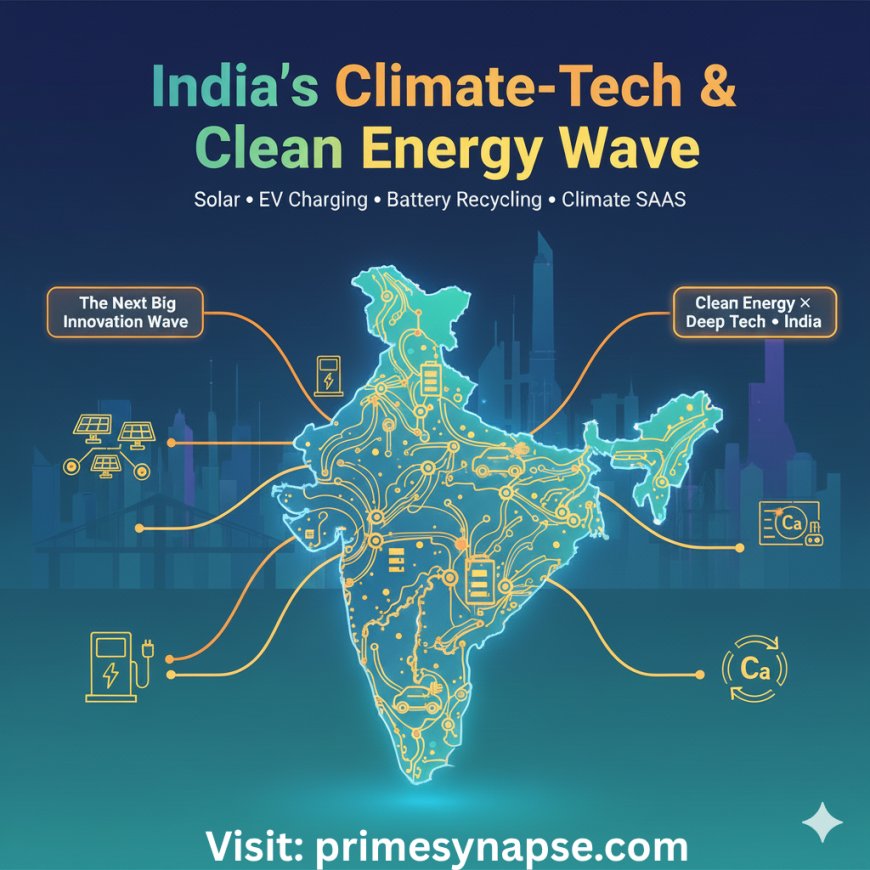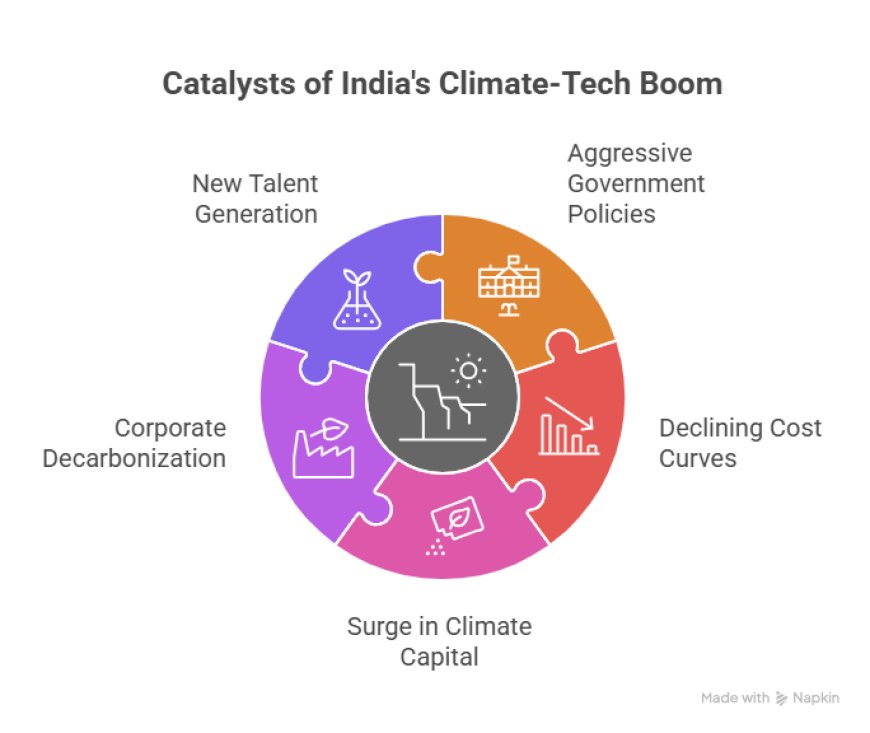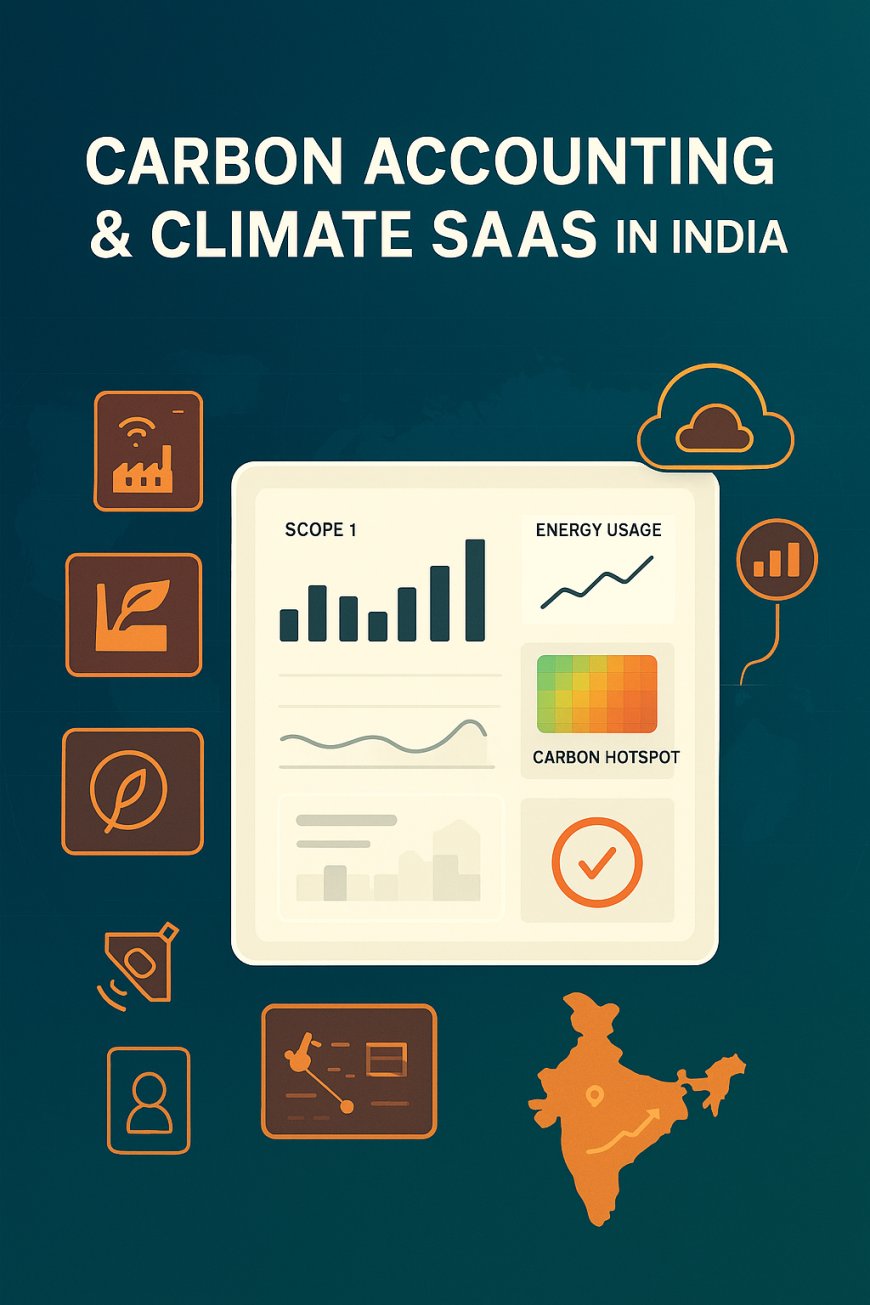India’s Climate Tech & Clean Energy Wave
India is entering a massive climate-tech boom—from EVs and solar to carbon accounting and battery recycling. Here’s why the next decade belongs to clean energy innovators.

India is entering a transformative decade—one where climate risk and climate innovation collide to redefine the country’s growth trajectory. Rising heatwaves, extreme rainfall, water stress, and air pollution are no longer distant threats; they’re economic realities pushing businesses, cities, and governments toward urgent solutions.
But alongside this risk lies a trillion-dollar opportunity: building the clean technologies, infrastructure, and systems that will power India’s future.
India’s commitment to Net Zero by 2070 has accelerated this shift. It has catalyzed an ecosystem of innovators, founders, and researchers working across renewable energy, mobility, carbon removal, and circular material systems. From solar tech to energy storage, from sustainable agriculture to climate analytics—India is witnessing a rapid expansion of climate-tech entrepreneurship.
What’s most significant is the structural transition underway:
India is moving from a fossil-heavy, centralized, infrastructure-driven energy economy toward a clean, distributed, tech-enabled one.
This shift is reshaping industries, supply chains, and jobs—and laying the foundation for India to become one of the world’s biggest climate-tech markets over the next decade.
The Drivers Behind India’s Climate-Tech Boom
India’s climate-tech wave isn’t accidental. It’s the result of aligned forces—policy, technology, capital, corporate pressure, and talent—all accelerating in the same direction. Here are the biggest catalysts:
a. Aggressive Government Policies & National Missions
The government is actively pushing clean energy and climate innovation through a series of high-impact programs:
- Production-Linked Incentive (PLI) schemes for solar modules, green hydrogen, and advanced chemistry cell (ACC) batteries.
- National Green Hydrogen Mission aiming to position India as a global hub for low-cost green hydrogen.
- FAME-II and EV incentives boosting electric two-wheelers, three-wheelers, and charging networks.
- Push for rooftop solar and decentralized renewable energy (DRE) to drive household and industrial adoption.
These policies reduce risk for founders, attract investors, and help domestic manufacturing scale.
b. Declining Cost Curves in Solar, Batteries, and Electrification
Solar power is now the cheapest form of electricity in India.
Battery prices continue to fall, making EVs, battery swapping, and grid-scale storage more viable.
Electrification—across factories, mobility, and homes—is becoming economically competitive, not just environmentally responsible.
This cost decline is the backbone enabling climate-tech startups to scale.

c. Surge in Climate-Focused VC & Private Capital
Investors are pouring money into climate solutions:
- Global climate-tech funds entering India
- Indian VCs setting up dedicated climate or deep-tech funds
- Corporate venture arms investing in green energy, EV infra, and carbon solutions
Capital is shifting from “nice-to-have sustainability projects” to hard-tech, infra-tech, and scalable climate innovation.
d. Corporates Embracing Decarbonization & ESG
Large Indian and global companies face rising pressure:
- Mandatory Business Responsibility & Sustainability Reporting (BRSR)
- Investor and customer expectations around climate action
- Need to decarbonize supply chains, logistics, and manufacturing
This surge in corporate climate commitments is creating an enormous market for:
- Carbon accounting
- Energy management software
- Renewable energy procurement
- Circular materials and waste solutions
e. A New Generation of Climate & Deep-Tech Talent
India’s young workforce is increasingly choosing careers in:
- Sustainability
- Battery chemistry
- Material science
- Agri-tech
- Carbon removal
- Energy optimization
- Environmental data and AI
Universities and incubators are launching climate-tech programs, while engineers from software and IT backgrounds are shifting into climate problem-solving.
Talent → innovation → scale is becoming a reinforcing loop powering the sector.
Solar Micro-Grids: Powering Rural India & Industrial Users
India’s climate-tech revolution is unfolding not just in big cities, but across rural and semi-urban regions—powered by a new wave of solar micro-grids. These decentralized systems are bringing reliable, affordable, and clean electricity to places where the traditional grid has struggled for decades.
Why Micro-Grids Matter
Solar micro-grids solve three core challenges simultaneously:
- Decentralization: Power is generated close to the point of use, reducing transmission loss and improving resilience.
- Affordability: Solar plus storage is now cheaper than diesel generators or unreliable grid supply.
- Reliability: Micro-grids ensure 24/7 access, especially important for agriculture, small businesses, and community institutions.
At a time when climate impacts increasingly disrupt large grid systems, micro-grids offer stability and energy independence.
Innovation in Rooftop Solar, Smart Meters & Storage
The sector is witnessing rapid innovation:
- Rooftop solar systems with smart inverters and remote monitoring
- Smart meters enabling real-time billing, prepaid models, and load optimization
- Battery storage solutions—from lithium-ion to emerging sodium-ion and flow batteries
These innovations make micro-grids more efficient, scalable, and financially viable.
Startups Leading Last-Mile Electrification
A growing number of climate-tech startups are:
- Deploying community-owned solar grids
- Offering pay-as-you-go solar for rural SMEs
- Building software layers for grid management and predictive maintenance
- Driving solar-powered irrigation, cold storage, and rural micro-enterprises
This wave is improving quality of life while unlocking rural economic resilience.
Industrial & Commercial Solar: A Massive Market
Beyond rural electrification, India’s commercial and industrial (C&I) sectors are adopting solar at record speed.
Factories, warehouses, and office parks are installing:
- Rooftop solar
- Behind-the-meter storage
- Hybrid solar-wind systems
With rising energy costs and sustainability mandates, C&I solar has become one of the biggest revenue pools in India’s clean energy industry.
EV Charging Networks: The Infrastructure Race
India’s EV transition is accelerating rapidly—fueled by electric two-wheelers, three-wheelers, and logistics fleets. As adoption soars, the real battle is shifting to infrastructure: charging networks, battery swapping, grid integration, and renewable-powered mobility ecosystems.
The EV Boom Across 2W, 3W & Fleet Logistics
India’s EV growth story is uniquely bottom-up:
- Two-wheelers and three-wheelers represent the majority of EV sales
- Fleet operators—delivery, mobility, logistics—are shifting electric to cut costs
- Urban and semi-urban cities are emerging as EV hotspots
This Fleet-first + 2W/3W-first model gives India a completely different trajectory from Western markets.
Charging Startups Building the Backbone
A diverse ecosystem of startups and corporates is racing to build:
- Fast-charging stations along highways and within cities
- Home charging solutions for apartments and gated communities
- Battery swapping networks for scooters and three-wheelers
- EV hubs for commercial fleets
Many players are also integrating software for:
- Station discovery
- Smart billing
- Fleet energy management
- Predictive maintenance
The goal: make charging seamless, reliable, and widely accessible.
Role of DISCOMs & Smart Grid Integration
DISCOMs (power distribution companies) are becoming key partners:
- Integrating EV loads into local grids
- Enabling time-of-day pricing
- Preventing grid stress through smart charging
- Supporting renewable-powered charging stations
Smart grids + distributed renewable energy will define India’s next-gen EV infra.
India’s Model vs US/China
India’s EV infrastructure approach differs fundamentally:
- India is more focused on 2W/3W + fleet charging, unlike the US (personal cars) or China (large state-led infra).
- Battery swapping is uniquely suited to India’s commercial mobility patterns.
- Cost-first, mass-market adoption drives Indian innovation.
- Private startups lead infrastructure build-out, not just state planning.
This bottom-up model could position India as a global exporter of EV infra innovation.
Battery Recycling & Energy Storage Innovation
India is entering a pivotal decade for energy storage—one that brings massive opportunity alongside a looming waste challenge.
India’s Imminent Battery Waste Crisis
As EV adoption accelerates, India faces a sharp rise in lithium-ion battery waste.
By 2030, the country is expected to generate millions of discarded EV, consumer electronics, and grid-storage batteries.
This presents both a risk (environmental pollution, landfill pressure) and a huge economic opportunity (recoverable lithium, nickel, cobalt, graphite).
Lithium-Ion Reuse & Second-Life Applications
Before reaching end-of-life, Li-ion batteries can be repurposed for:
- Stationary energy storage
- Backup power solutions
- Solar micro-grid storage
- Low-demand electric mobility (e-rickshaws, cycles)
Second-life batteries are becoming a cost-efficient way to support renewable energy systems and rural electrification.
Recycling Technology & Circular Supply Chains
A new wave of startups is building India’s battery circularity layer:
- Hydrometallurgical and pyrometallurgical recycling to recover critical minerals
- Automated battery dismantling lines
- AI-based battery diagnostics to assess cell health
- Reverse logistics networks for collecting used batteries
This circular approach reduces import dependence, strengthens India’s energy security, and supports domestic value creation.
Innovation Beyond Lithium-Ion
India’s climate-tech wave is also accelerating innovation in alternative storage technologies:
- Sodium-ion batteries — cheaper, safer, and ideal for mass adoption in EV scooters and energy storage
- Thermal storage systems — supporting industrial heating, cooling, and grid balancing
- Green hydrogen storage — emerging as a long-term solution for heavy industry and logistics
With global supply chains shifting, India has the potential to become a key hub for next-gen energy storage R&D and manufacturing.
Carbon Accounting, ESG Data & Climate SaaS
As climate regulations tighten and global supply chains demand transparency, India is witnessing a surge in carbon accounting and climate-software platforms.
The Rise of Carbon Reporting Mandates
Enterprises—especially exporters—are now required to measure and disclose emissions under:
- Corporate sustainability reporting directives
- Green supply chain requirements from global buyers
- Net-zero commitments by multinational corporations
- Domestic ESG-related norms and climate-risk disclosures
This shift makes carbon accounting no longer optional—it’s a business survival requirement.

Tools to Measure, Track & Reduce Emissions
Climate-tech startups are building digital products that help companies:
- Calculate Scope 1, Scope 2, and increasingly Scope 3 emissions
- Track energy usage, waste generation, water consumption
- Identify decarbonization hotspots
- Run simulations to forecast emissions under different scenarios
- Generate compliance-ready ESG reports
These tools reduce the complexity of carbon measurement and offer actionable insights, not just dashboards.
The Rise of Climate SaaS & MRV Platforms
India’s emerging climate-software stack includes:
- MRV systems (Measurement, Reporting, Verification) for carbon credits
- ESG data intelligence platforms
- Carbon offset management tools
- Sustainability workflow automation
- Procurement-linked carbon visibility tools
These platforms help corporations, SMEs, and even government agencies measure climate risk and comply with evolving regulations.
AI, IoT & Supply Chain Integration
To ensure accuracy and automation at scale, climate SaaS is increasingly integrating with:
- IoT sensors (for real-time energy and emissions data)
- Satellite imagery (for land-use and carbon project verification)
- AI/ML models (to forecast emissions and recommend reductions)
- Supply chain systems (for vendor-level emissions transparency)
This integration ensures end-to-end visibility—from factory floors to global logistics networks.
The Emerging Startup Landscape (Deep Dive)
India’s climate-tech ecosystem is rapidly diversifying. What began as a solar and EV movement has now evolved into a multi-layered innovation landscape spanning energy, mobility, materials, agriculture, and carbon markets. Below is a detailed look at the categories defining India’s new climate economy.
1. Energy: Solar, Storage, Hydrogen & Smart Grids
These startups form the backbone of India’s clean energy shift.
- Solar innovation: rooftop solutions, industrial solar EPC, micro-grids, community solar
- Energy storage: lithium-ion, sodium-ion, hybrid storage, second-life batteries
- Green hydrogen: electrolyzer manufacturing, hydrogen production, hydrogen mobility
- Smart grids: real-time demand response, automated load balancing, AI-powered energy management
These companies are solving India’s fundamental infrastructure challenges while enabling distributed, low-cost energy access.
2. Mobility: EVs, Charging Networks & Fleet Electrification
India’s mobility transition is moving faster than most developed markets.
- EV manufacturers across 2W, 3W, and light commercial vehicles
- Charging networks: fast charging, home charging, workplace charging, battery swapping
- Fleet electrification platforms for logistics, delivery, and mobility-as-a-service
- Battery-as-a-Service models reducing EV ownership barriers
The ecosystem is uniquely Indian, built around affordability, density, and fleet-driven demand.
3. Materials: Bioplastics, Green Cement & Alternative Proteins
Hard-to-abate sectors are seeing a wave of material-science innovation.
- Bioplastics from starch, agri-residues, seaweed
- Green cement and low-carbon construction materials
- Bio-based packaging for D2C and grocery brands
- Alternative proteins (plant-based, fermentation-based) for sustainable food systems
These innovations target India’s massive manufacturing and FMCG sectors, helping reduce Scope 3 emissions.
4. Agritech: Precision Irrigation & Carbon-Positive Farming
Agriculture represents both a climate risk and climate opportunity.
Startups are focusing on:
- Precision irrigation (IoT sensors, automated drips, soil health monitoring)
- Regenerative farming and soil-carbon enhancement
- Heat-resilient and drought-tolerant crops
- Agri-waste valorization into fuel, raw materials, or carbon credits
- Farmer marketplaces for climate-resilient inputs
These solutions help millions of farmers adapt to climate change while generating new income streams.
5. Carbon Markets: Offsets, MRV & Climate Finance Tools
One of the fastest-growing climate-tech categories in India.
Key innovations include:
- Carbon offset marketplaces
- MRV systems (Measurement, Reporting, Verification) for project authenticity
- Carbon finance platforms connecting corporates with climate projects
- Tokenized carbon trading using blockchain for transparency
- Supply chain decarbonization tools for exporters and manufacturers
With global buyers demanding verified low-carbon products, this sector is becoming strategic for India’s export competitiveness.
Challenges India Must Overcome
Despite its momentum, India’s climate-tech revolution faces structural and operational challenges that must be solved for long-term success.
1. High Capital Requirements & Slow Infrastructure Rollout
Climate-tech—especially in energy, mobility, and materials—is capital-intensive.
Challenges include:
- Long payback periods
- High cost of hardware
- Slow permitting and grid-connection processes
- Financing challenges for early-stage deep-tech startups
Scaling to national-level impact requires significant public and private investment.
2. Fragmented Regulations & State-Level Policy Differences
Climate and energy policy in India is decentralized.
- Solar and EV regulations differ across states
- Power tariffs and net-metering policies are inconsistent
- Carbon market rules are evolving
- Local approvals can be slow and variable
Startups must navigate a patchwork of rules, which slows adoption and commercialization.
3. Need for Skilled Talent in Deep Tech & Hardware
India has strong software talent but limited deep-tech and hardware expertise.
Gaps exist in:
- Battery chemistry
- Material science
- Hydrogen technologies
- Advanced manufacturing
- Grid engineering & power electronics
Climate-tech success demands a new talent pipeline—engineers, scientists, hardware operators.
4. Reliability of Carbon Credits & MRV Systems
Global buyers increasingly demand:
- Verified, high-quality offsets
- Transparent MRV
- Reliable data from energy and agriculture projects
India must improve project verification, monitoring systems, and guard against greenwashing to maintain trust in its carbon markets.
5. Supply Chain Dependency on Imported Materials
India’s clean energy push runs into supply chain realities:
- Lithium, nickel, cobalt—primarily imported
- Dependence on China for battery cells, solar wafers, and modules
- Limited domestic capacity in electrolyzers and advanced materials
To become a climate-tech powerhouse, India must build robust local manufacturing ecosystems.
The Opportunity: India as a Global Climate-Tech Leader
India stands at the intersection of scale, urgency, and innovation — a combination that uniquely positions it to lead the global climate-tech wave. Few countries have both the environmental pressure and the market size to deploy climate solutions at scale. India does.
1. India’s Massive Scale → A Living Lab for Climate Solutions
With 1.4 billion people, India offers:
- Diverse climate zones
- Urban density and rural spread
- Extreme weather challenges
- Heavy industrial presence
- Rapidly growing energy demand
This scale allows startups to test, iterate, and validate climate technologies in real-world environments far faster than most global markets.
2. Export Potential: EV, Solar & Clean-Tech Innovations
India is rapidly evolving from an importer of clean technologies → to a global exporter.
Opportunities include:
- EV manufacturing (2W, 3W, commercial fleets)
- Battery recycling and second-life solutions
- Solar micro-grid technology
- Smart metering and energy management systems
- Bioplastics and green materials
- Climate SaaS and carbon measurement tools
As global markets race to decarbonize, India's low-cost, high-scale solutions can become international standards.
3. Rural & Industrial Markets as Growth Catalysts
Two unique segments drive India’s climate-tech adoption:
- Rural India: perfect for solar micro-grids, irrigation tech, agri-waste-to-energy models
- Industrial clusters: massive demand for renewable energy, electrification, and carbon reporting
These segments create a dual-speed climate-tech market—one driven by necessity, the other by compliance and competitiveness.
4. Climate Tech → India’s Next Big Startup Wave
Fintech and SaaS defined India’s past decade. Climate tech is shaping the next.
Why?
- Huge market size
- Deep-tech + engineering opportunities
- Government support
- Global investor interest
- Export potential
Climate tech is emerging as India’s new frontier of innovation, investment, and impact — the next trillion-dollar opportunity.
Conclusion:
India’s climate-tech revolution is no longer theoretical — it’s already unfolding. What once felt like niche innovation has now become the backbone of India’s future economic strategy.
Key truths define the road ahead:
- Climate tech is India’s next economic engine
- Startups, corporates, and government are aligned toward a cleaner, more resilient future
- Distributed energy, electrified mobility, and circular materials will redefine India’s infrastructure
- Carbon accounting and climate SaaS will be mandatory business functions
- Indian innovation will shape global decarbonization outcomes
As the world races toward net zero, India isn’t just catching up — it’s leading with scalable, affordable, inclusive climate innovation.
The next decade will belong to founders, technologists, manufacturers, and policymakers who embrace clean energy and climate-tech solutions.
This is India’s climate-tech decade — and the world is watching.
What's Your Reaction?
 Like
0
Like
0
 Dislike
0
Dislike
0
 Love
0
Love
0
 Funny
0
Funny
0
 Angry
0
Angry
0
 Sad
0
Sad
0
 Wow
0
Wow
0

























































































































































































